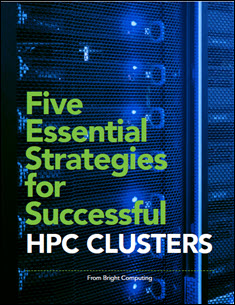In today’s markets, a successful HPC cluster can be a formidable competitive advantage. And many are turning to these tools to stay competitive. That said, these systems are inherently very complex, and have to be built, deployed and managed properly to realize their full potential. Improper implementation can hinder your enterprise’s ability to meet implementation deadlines, quickly identify and resolve problems, perform updates and maintenance and more.

Download the full report.
Bright Computing highlights this advice in a new white paper, “Five Essential Strategies for Successful HPC Clusters.”
This report outlines five strategies from Bright Computing, that act as guidelines for effectively building and managing an HPC cluster:
- Understand the real cost of open source tools and homegrown approaches to cluster management.
- Plan for change and scalable growth.
- Plan to support a range of new and different hardware.
- Be one with the cloud.
- Be ready for machine learning and other applications.
The report offers a bit of background on HPC clusters, explaining that “extracting value from a collection of raw hardware can be challenging.”
Do-it-yourself approaches may demonstrate an initial victory, but they are vulnerable to ‘breakage’ when change is needed. They tend to be very ‘guru’ dependent, requiring that the person who set-up the system also maintain it.” — Bright Computing
In the early days of Linux HPC clustering, Ethernet and InfiniBand, and installing Linux OS and HPC software may have been fairly simple. But times are changing.
“Today, cluster-based HPC has evolved into a mature market segment with many more hardware and software choices than in the past, and the expanded decision space puts further pressure on organizations to ‘get it right,'” the report stated.
The success of cluster lies in its utilization by end users. Bright Computing notes what it sees at three key factors that influence utilization, defined further in the report:
- Availability
- Extensibility
- Support
Bright Computing also breaks down the building blocks of HPC, which have evolved heavily over the years, and now include options like multi-core Intel x86-architecture worker nodes with varying amounts of cores and memory.
“And while the majority of systems in use are based on x86 processors, Power and Arm-based systems are growing in number,” the report stated.
Ultimately, business needs and new hardware and technologies are changing the way that organizations need to build and manage high-performance clusters. And static, inflexible clusters often are not enough to adequately meet the needs of today’s businesses.
Download the full report, “Five Essential Strategies for Successful HPC Clusters.” courtesy of Bright Computing, to explore best practices for building, deploying and managing an HPC cluster.




